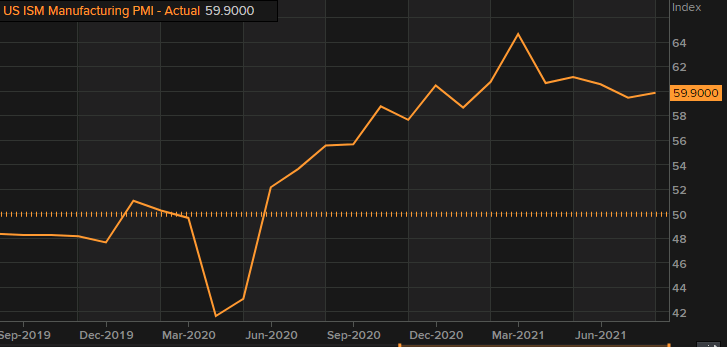US August ISM manufacturing data
- Prior was 59.5
- Prices paid 79.3 vs 83.8 expected (prior was 85.7)
- Employment 49.0 vs 52.9 prior
- New orders 6637 vs 64.9 prior
- Full report
That miss on employment might get some attention after today’s ADP report and ahead of non-farm payrolls. Manufacturing isn’t a big US employer but it’s another soft data point on that front.
More details:
- production 60.0 versus 58.4 in July
- supplier deliveries 69.5 versus 72.5 last month
- inventories 54.2 versus 48.9 last month
- customer inventories 30.2 versus 25.0 last month
- backlog of orders 68.2 or 65.0 last month
- new export orders 56.6 versus 55.7 last month
- imports 54.3 versus 53.7 last month
Comments in the report:
- “The chip shortage is impacting supply lines. So far, we’ve been
able to manage it without impacting clients.” [Computer & Electronic
Products] - “Some factories have been impacted by COVID-19 cases. Malaysian
government says factories can operate at only 60 percent of capacity.”
[Computer & Electronic Products] - “We continue to see extended lead times due to port delays and sea
container tightness. Manufacturing capacities are impacted by a lack of
workers reducing output. Several chemical facilities have experienced
fires, explosions and spills, further challenging suppliers’ ability to
deliver on time and in full.” [Chemical Products] - “Strong sales continue, but production is limited due to supply issues with chips.” [Transportation Equipment]
- “Supply chain functions have been relentlessly challenging. All
things from freight (both over the road and ocean), already constrained
labor forces are further exacerbated by COVID-19 absenteeism. Also, high
prices everywhere are wearing our employee base down.” [Food, Beverage
& Tobacco Products] - “Oil prices have remained higher than planned and is helping to
secure capital funds and project sanctions for 2021-22 projects.”
[Petroleum & Coal Products] - “Bookings/sales continue to be strong. Persistent supply issues –
including availability of materials, freight/logistics/containers, and
allocation of key commodities – continue to hamper production ramp to
meet demand. Also struggling with lack of labor in several factories.
Commodities are still inflationary, but price increases have leveled.”
[Furniture & Related Products] - “Business is strong. Part shortages are our largest business
constraint. We cannot fulfill orders to customers in reasonable lead
times. Now booking out into 2022, and it will get worse as we hit our
cyclical high demand in the fourth quarter.” [Electrical Equipment,
Appliances & Components] - “Business is going strong, but raw material prices still under
increasing price pressure. Labor is still an issue.” [Plastics &
Rubber Products] - “Continue to be unable to hire hourly personnel or machine operators
due to few applicants. Steel and aluminum remain in short supply. New
business continues to grow and come in. Unable to handle influx of
orders without staff, both hourly and salaried.” [Fabricated Metal
Products] - “Customer order backlog continues to climb because we are unable to
raise production rates due to supplier parts and manpower challenges.
Continue to see price increases with key commodities, and logistics is
an ongoing challenge that has no end in sight.” [Machinery]
Comment from the ISM chair:
“Business Survey Committee panelists reported that their companies and
suppliers continue to struggle at unprecedented levels to meet
increasing demand. All segments of the manufacturing economy are
impacted by record-long raw-materials lead times, continued shortages of
critical basic materials, rising commodities prices and difficulties in
transporting products. The new surges of COVID-19 are adding to
pandemic-related issues – worker absenteeism, short-term shutdowns due
to parts shortages, difficulties in filling open positions and overseas
supply chain problems – that continue to limit manufacturing-growth
potential. However, optimistic panel sentiment remained strong, with
eight positive comments for every cautious comment … Disruptions from COVID-19, primarily in Southeast Asia, are having
dramatic impacts on many industry sectors. Ports congestion in China
continues to be a headwind as transportation networks remain stressed.
